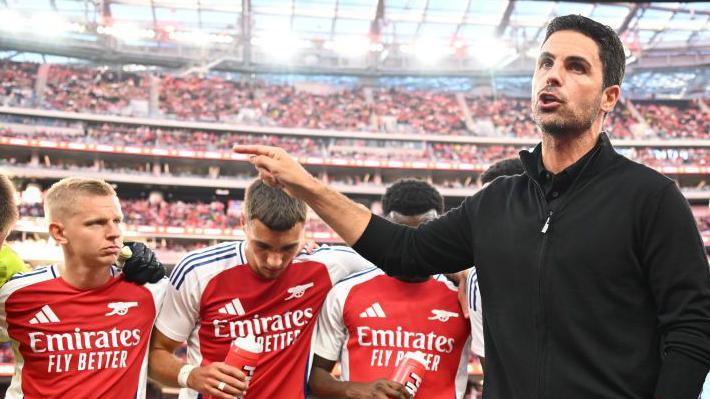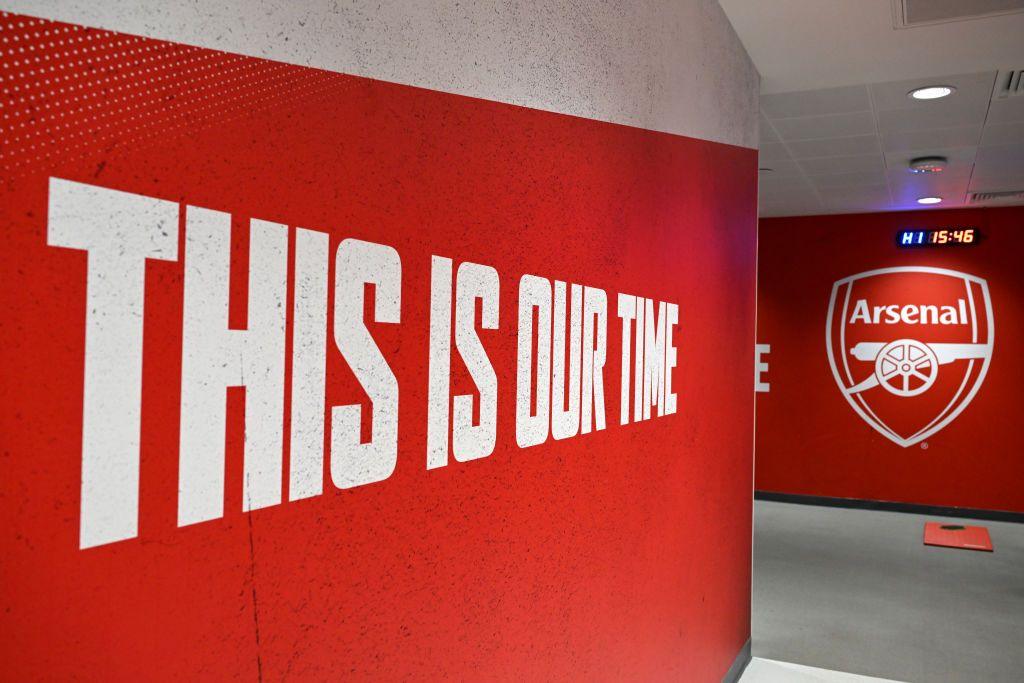Three things we learned from Arsenal's America tour

Arsenal have finished second in the Premier League in the past two seasons
- Published
Spending time around the Arsenal camp in the United States, it was impossible to escape the feeling this is a club united.
Intense on the training pitch and in games, away from it manager Mikel Arteta was relaxed - far removed from the tetchy figure we sometimes see on the touchline - and technical director Edu appears a man in control of his remit.
Edu's job these days is to sift through the numerous agents offering Arsenal their players. He comes across as a clear-minded individual, not one to fall for the promise of a shiny new toy with no substance to it.
Results can mask many issues at football clubs but there is a sense of purpose around Arsenal - and even goodwill towards the ownership, which is remarkable considering the fury launched upon them at the height of the Super League debacle.
Their aim is to improve - and to win. That is not easy given they have amassed 84 and 89 points respectively to finish second in the Premier League for the past two seasons. The only club to finish above them is Manchester City.
When asked before the Bournemouth game in Los Angeles if it was possible to improve after two almost perfect seasons, Arteta's answer was clear: "We have to."
The process for achieving it has been compared internally to a software update. Arsenal are trying to address the weaknesses and bugs that have been identified. This is not about subtle tweaks. This is a system upgrade.
"We want to improve in everything," said Arteta. "Attacking metrics, defensive metrics, restarts, set-piece."
The challenge to overtake his former club City is one Arsenal will not shy away from.
Here's three key areas from the US tour.
Arsenal signing Calafiori - all you need to know
- Published29 July 2024
Salah and Carvalho give Liverpool win over Arsenal
- Published1 August 2024
Timber to make up for false start?
There was a great deal of excitement around Jurrien Timber 12 months ago.
The Gunners paid Ajax £38m for the Netherlands defender and his arrival had been a little under the radar compared to that of Declan Rice.
He had impressed in pre-season, playing the inverted right-back role, before a knee injury in the season opener that kept him out until the final game of the campaign.
Now he is back in an Arsenal shirt and, while he was left out of the final tour match with Liverpool in order to protect him, he did impress against Bournemouth and Manchester United.
Asked about him as a potential rival for his shirt, team-mate Oleksandr Zinchenko described Timber’s on-pitch ability as 'unbelievable'.
As someone who can play across the backline, Timber's versatility could be invaluable. But I suspect Arteta has a specific role earmarked for him. He could be a key man for Arsenal this term.
Arsenal 1-2 Liverpool: We have to evolve and improve
Unfair criticism? What role for Havertz?
Arteta felt the negativity around Kai Havertz's arrival at Arsenal last summer from Chelsea was unfair. The reaction only was heightened by some below-par performances early in the season.
Yet, in the absence of a centre-forward many Arsenal fans believe should be an essential aspect of the club's summer recruitment, the Germany forward could turn out to be a key part of the Gunners' drive for honours.
He cannot be a number nine in the conventional sense like Erling Haaland, who pins defenders back with his strength. But his intelligence can create pockets of space in dangerous areas that can be exploited, by him or team-mates. His goal against Liverpool in Philadelphia was an example of that.
The intriguing bit will be whether he is used as a false nine or in a deeper role, which allows Gabriel Jesus to play more centrally.
As ever with Havertz, opinions are polarised. But to those who have reacted negatively to his performances in the United States, Arteta offered a reminder that the former Chelsea man had only had four training sessions and still made an impact.
Battle for places - Arteta's biggest challenge
Signing Italy defender Riccardo Calafiori during the three-match tour of the United States and flying him to Philadelphia to train with his new team-mates - and the subsequent move for Real Sociedad defender Mikel Merino - is proof Arsenal are not prepared to accept finishing second as the limit of their achievements.
For that to happen, Arsenal need better players, but increasing competition for places brings with its own problems.
Managing a group of players is as much about how you deal with the ones who don't get picked as much as the ones that do. And that is Arteta's challenge.
Where will Calafiori play is a key question on the lips of Arsenal fans. The same is also true of Timber.
But in a sense, that is not the crucial point. It should be 'who gets left out?'.
It is easy to see Zinchenko for instance not getting a spot in Arteta's new-look side. But his ability and versatility means the Ukraine international could be useful off the bench or to step in should injuries occur - and the chances are they will.
Arteta needs his back-up players to be on board with the messaging and willing to help the team.
For all the plaudits he receives for tactical innovation, that is probably the biggest challenge for Arteta this season. How well he meets it could determine whether Arsenal end their 20-year wait for a title.
Related topics
- Published26 July 2022

